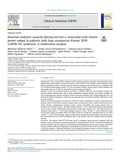Mostrar el registro sencillo del ítem
Maximal oxidative capacity during exercise is associated with muscle power output in patients with long coronavirus disease 2019 (COVID-19) syndrome. A moderation analysis.
| dc.creator | Ramírez Vélez, Robinson | es_ES |
| dc.creator | Oscoz Ochandorena, Sergio | es_ES |
| dc.creator | García Alonso, Yesenia | es_ES |
| dc.creator | Garcia Alonso, Nora | es_ES |
| dc.creator | Legarra Gorgoñon, Gaizka | es_ES |
| dc.creator | Oteiza Olaso, Julio | es_ES |
| dc.creator | Ernaga Lorea, Ander | es_ES |
| dc.creator | Izquierdo Redín, Mikel | es_ES |
| dc.creator | Correa Rodríguez, María | es_ES |
| dc.date.accessioned | 2024-02-29T12:51:55Z | |
| dc.date.available | 2024-02-29T12:51:55Z | |
| dc.date.issued | 2023 | |
| dc.identifier.citation | Ramírez-Vélez, R., Oscoz-Ochandorena, S., García-Alonso, Y., García-Alonso, N., Legarra-Gorgoñon, G., Oteiza, J., Erneaga Lorea, A., Izquierdo, M., Correa-Rodríguez, M. (2023) Maximal oxidative capacity during exercise is associated with muscle power output in patients with long coronavirus disease 2019 (COVID-19) syndrome. A moderation analysis. Clinical Nutrition, 58, 253-262. https://doi.org/10.1016/j.clnesp.2023.10.009. | es_ES |
| dc.identifier.issn | 0261-5614 | |
| dc.identifier.uri | https://hdl.handle.net/2454/47592 | |
| dc.description.abstract | Background & aims: Long COVID syndrome (LCS) involves persistent symptoms experienced by many patients after recovering from coronavirus disease 2019 (COVID-19). We aimed to assess skeletal muscle energy metabolism, which is closely related to substrate oxidation rates during exercise, in patients with LCS compared with healthy controls. We also examined whether muscle power output mediates the relationship between COVID-19 and skeletal muscle energy metabolism. Methods: In this cross-sectional study, we enrolled 71 patients with LCS and 63 healthy controls. We assessed clinical characteristics such as body composition, physical activity, and muscle strength. We used cardiopulmonary exercise testing to evaluate substrate oxidation rates during graded exercise. We performed statistical analyses to compare group characteristics and peak fat oxidation differences based on power output. Results: The two-way analysis of covariance (ANCOVA) results, adjusted for covariates, showed that the patients with LCS had lower absolute maximal fatty acid oxidation (MFO), relative MFO/fat free mass (FFM), absolute carbohydrates oxidation (CHox), relative CHox/FFM, and oxygen uptake (V__O2) at maximum fat oxidation (g min1 ) than the healthy controls (P < 0.05). Moderation analysis indicated that muscle power output significantly influenced the relationship between LCS and reduced peak fat oxidation (interaction b ¼ 0.105 [95% confidence interval 0.174; 0.036]; P ¼ 0.026). Therefore, when muscle power output was below 388 W, the effect of the LCS on MFO was significant (62% in our study sample P ¼ 0.010). These findings suggest compromised mitochondrial bioenergetics and muscle function, represented by lower peak fat oxidation rates, in the patients with LCS compared with the healthy controls. Conclusion: The patients with LCS had lower peak fat oxidation during exercise compared with the healthy controls, potentially indicating impairment in skeletal muscle function. The relationship between peak fat oxidation and LCS appears to be mediated predominantly by muscle power output. Additional research should continue investigating LCS pathogenesis and the functional role of mitochondria. | en |
| dc.description.sponsorship | The EXER-COVID study was supported by «Proyectos de I+D+i» de los Programas Estatales de Generación de Conocimiento y Fortalecimiento Científico y Tecnológico del Sistema de I + D + i Orientada a los Retos de la Sociedad, en el marco del Plan Estatal de Investigación Científica y Técnica y de Innovación 2017–2020 (PID2020-113098RB-I00) | en |
| dc.format.mimetype | application/pdf | en |
| dc.language.iso | eng | en |
| dc.publisher | Elsevier | en |
| dc.relation.ispartof | Clinical Nutrition, 2023, vol. 58 | es_ES |
| dc.rights.uri | http://creativecommons.org/licenses/by/4.0/ | |
| dc.subject | Muscle strength | en |
| dc.subject | Muscle mass | en |
| dc.subject | Post-acute COVID-19 syndrome | en |
| dc.subject | Fatty acid oxidation | en |
| dc.title | Maximal oxidative capacity during exercise is associated with muscle power output in patients with long coronavirus disease 2019 (COVID-19) syndrome. A moderation analysis. | en |
| dc.type | Artículo / Artikulua | es |
| dc.type | info:eu-repo/semantics/article | en |
| dc.date.updated | 2024-02-29T12:42:57Z | |
| dc.contributor.department | Ciencias de la Salud | es_ES |
| dc.contributor.department | Osasun Zientziak | eu |
| dc.rights.accessRights | Acceso abierto / Sarbide irekia | es |
| dc.rights.accessRights | info:eu-repo/semantics/openAccess | en |
| dc.identifier.doi | 10.1016/j.clnesp.2023.10.009 | |
| dc.relation.projectID | info:eu-repo/grantAgreement/AEI/Plan Estatal de Investigación Científica y Técnica y de Innovación 2017-2020/PID2020-113098RB-I00/ES/ | |
| dc.relation.publisherversion | https://doi.org/10.1016/j.clnesp.2023.10.009 | |
| dc.type.version | Versión publicada / Argitaratu den bertsioa | es |
| dc.type.version | info:eu-repo/semantics/publishedVersion | en |



